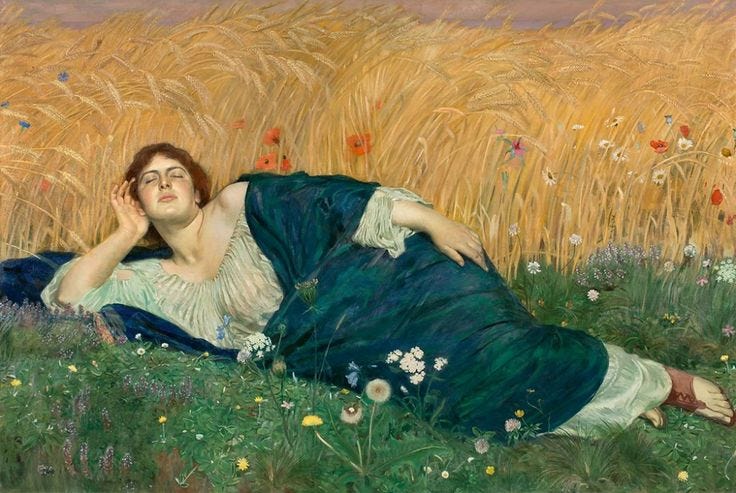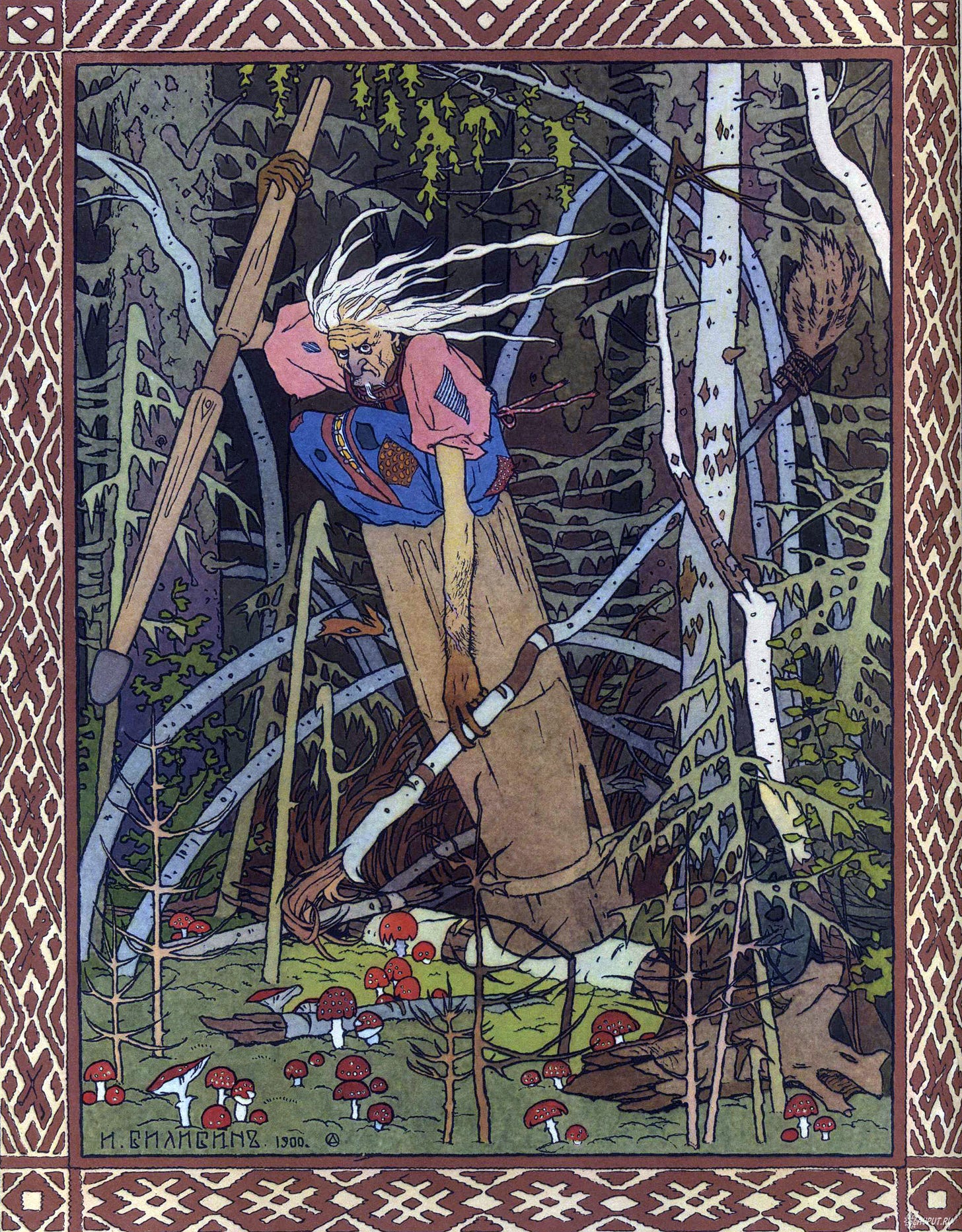What do a nun, a hermit and a witch have in common?
facets of an archetype that contact the liminal
Last weekend I spent two nights at a spiritual retreat centre. This was a solo, self-guided, swift immersion, i.e. by my own volition, no agenda. I went to this particular centre as it was local and quick to get to. Especially curious for me was that it was neighbours to a monastery of the Carmelite nuns1. I had no idea we had a Monastery in Brisbane! There was a welcome simplicity and austerity to the accommodations, which were spare (but clean and enough), and the location, gardens and grounds were truly peaceful and quite incredible. The Centre also had a walkable labyrinth!
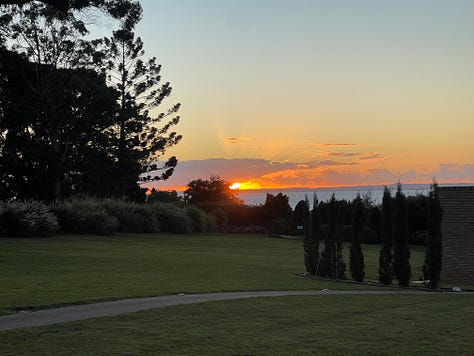
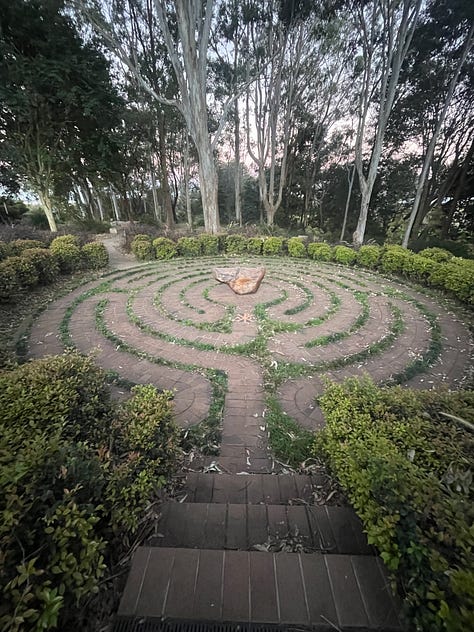
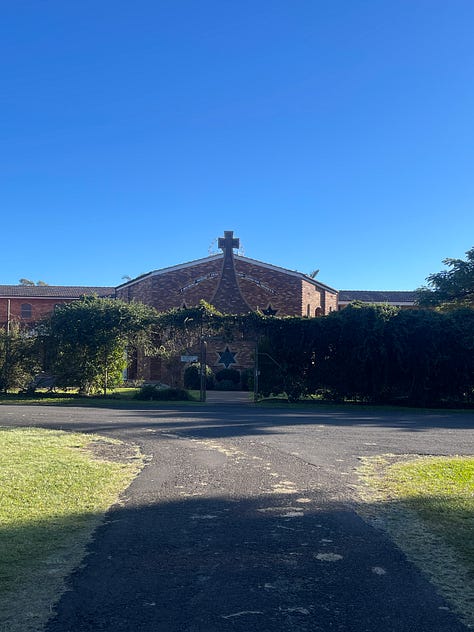
I haven’t taken time off in a while, and it felt quite necessary now, for a) restoration, and b) to make space for tending to a spiritual practice that was becoming a little stale ( I pointed to this in this article with the question “Am I spiritual enough?"). Also, I’ve a thrumming desire to run live retreats or weekend workshops, and I was on reconnaissance to see if this venue would work.
Long story short, I felt psychically and spiritually clearer afterwards, and yes, it could work as a venue. But this isn’t what I want to delve into today. I’ve been more curious about how certain archetypal energies and themes have catalysed from this experience and appreciate this space to flesh this out.
The hope is that either you recognise or resonate with these experiences so making it helpful for you too, or it’s encouragement to notice what themes and archetypes feature strongly in your life. As Caroline Myss teaches, “ A good rule in general when considering your archetypes is that they must represent characteristics that are continually at work in several areas of your life”
For me, multiple desires were calling me to cloister.
Lonely vs alone?
I often touch on the difference between solitude and loneliness, and the knife edge that separates them. I love solitude, but my quest for it often tips me into loneliness. It is a difficult balance to find.
adventurer, Alastair Humphries.
What my time away showed me was how very, very easy and comfortable it is for me to be alone. Granted, two days isn’t very long, but there was zero adjustment or settling period. And despite there being a chatty group there attending a labyrinth training, I easily slipped into a psychic seclusion.
Alone, therefore, points toward solitude, which feels chosen, pleasurable. Different to loneliness, which may suggest the pain of disconnection and a state you don’t feel in control of. This disconnect can be from real social isolation and lack of companionship, but also a state of inner separation from a spiritual essence or soul, or from the world through a lack of meaning.
How are you with being alone? Do you choose solitude? When have you experienced feeling lonely even in the presence of others?
Western psychology would say this points to an avoidant attachment style. And I’d agree to a point, but it's a little boring and limiting.
I encourage each of you to delve deeper into what symbols and themes might encircle your relational habits.
When harnessed, directed, and appreciated, a preference for solitude or a feeling of loneliness can also reveal gifts or purpose rather than a pure pathology. The same might go for those who have a preference for social contact.
I encourge you to flex your mystical muscles of non-linear thinking to explore the symbolic in your relational experiences. Symbols as images and felt experiences can offer a richer and more nuanced picture of what might be alchemising in your psyche. And so also offer direction for choices and change if needed.
For me I’m frequently visited by the nun in a convent, the hermit in a cave, the witch in the woods.
In another life, I could have been a nun.
A couple of years ago, the idea of living in a convent became a bit of a fantasy. Not one I wished for, as I am in a good marriage, and I enjoy my family. But sisterhood and convent life felt evocative. The Young Pope has a little to answer to here, as do the mystics Teresa of Avila (a Carmelite nun) and Julian of Norwich2. I knew it was pointing me to something that needed contemplation, not literalisation. What does nun suggest to me? What of the convent? Or monastery?

There’s a romantic vision of peace in place: the austerity, the stone, the arches, the simplicity in the spare living quarters, and predictable and structured daily rituals and dedicated spirituality. There’s something there in the religiosity that stirs. Also, first chakra themes of trust, safety and home. The aesthetic and the containment of daily life is very appealing. So I feel here, it's less about being alone, and perhaps more in a desire for being cloistered-shielded, protected or contained. Less responsibility perhaps? More to consider here…
The origin of the word Nun is linked to nurse, so healing and tending to the wounds of others fits. But I feel my resonance rests more in the culture of the convent and community of women contained within the stone walls. And I don’t think I am alone. In the US at least, convents are filling up with young women for season-long retreats (this young creator on TT is fretting how there is a waitlist). This seems to be speaking to some need for young women to check out, defrag, and connect to a simpler existence separate from men.
What could it be? The demands and expectations of the culture on women are calling many to escape? check-out? or rediscover a different way to be?
According to Barbara Walters, early Christian convents were institutions that evolved from pagan ‘colleges’ of priestesses, where unmarried women (not necessarily virgins) and men devoted themselves to divine service. They came under the rule of the abbess, who wasn’t always holy, and often a wealthy noblewoman or pagan queen who wanted a sainthood. They were also a place where women chose to go to ensure their financial sovereignty, taking vows as a way to protect land and money from potential husbands. More broadly, abbesses and high-prestesses (as they were still sometimes known) had much financial, political, and secular power. Convents were also places of high learning.
But from the 12th century, the church began to assert patriarchal claims on the nuns' property and personhood. Their “wickedness” justified taking their property, denying access to education, and enforcing sexual segregation of the devout. Seclusion and cloistering also began to be enforced at this time.
So perhaps it’s the original idea of convent as a place for feminine power to burgeon and where sovereignty was assumed that calls me? A place of collaboration and of women practising religiosity on their terms, that draws me and others in.
If you are enjoying the read so far, consider liking this post 🖤
“I'm happy being a hermit in a cave”
This fantasy/vibe of being a hermit frequently was on my tongue during the time that COVID coincided with my mid-life passage - a chapter of life that naturally activates a strong urge to recluse. So this mid-life journey + lockdowns + moving my psychology practice online felt synchronistic.
The Hermit archetype is typically of an old man, consciously living or existing in solitude and deep reflection as a pilgrimage toward inner discovery and alignment. In the tarot, his image often carries a lantern - one that casts only a small halo of light that suggests just moving into space only as far as you can see. Infinite patience and dedication to bringing unconscious (darkness, unknown) into consciousness (clarity, known) are core qualities of the Hermit. The symbolism of cave - as opening in the earth, as womb, gestation, as tomb, is also rich. Caves are portals between life and death. Edge spaces of transformation and spiritual climax.
Do you recall a time of solitude that helped you to reorient how you lived in the world? Like a rebirth?
Some of you may remember that last year I went on a 5-week quest to train with Dr E in the US, then to revisit Balkan homelands. That period felt quite liminal, and loneliness pain was very present but not awful. I was lonely but with a sense of meaning and purpose, acting as a beacon or anchor. I appreciated that solitaryness was crucial to the deeper alchemical processes inherent to this ancestral journey. And there was a palpable aftermath, where the months following my return home signalled intense change, and freedom from old wounds in my family of origin relationship dynamics and obligations.
This makes me think of how in the tarot, a reversed Hermit can signal a time to return to live the wisdom obtained. As I write this, I see how this shift in self has coincided with this archetype fading a little as I enjoy a new sense of enjoyment out in the world.
Leave me to be a witch in the woods
Like the word wild the word witch has come to be understood as a pejorative, but long ago it was an appellation given to both old and young women healers, the word witch deriving from the word wit meaning wise. This was before cultures carrying the one-God-only religious image began to overwhelm the older pantheistic cultures which understood the Deity through multiple religious images of the universe and all its phenomena.
Clarissa Pinkola Estes-Reyes in ‘Women Who Run With the Wolves’
By now you are probably noticing that different facets of the same archetypal forces seem to be at play. Witch, though, is one archetype that’s so complex I won’t even attempt to summarise, and instead head straight to one witch in particular that gets to me: Baba Yaga. Baba Yaga appears in Slavic tales as an ancient hag, a crone, possibly a witch, possibly a goddess, who will test you. She lives in a house, raised on chicken legs that walk, twirl and dance, with a fence circling its perimeter decorated with human skulls. She won’t think twice about devouring you. Freaky.
“Do you come of your own free will, or do you come by compulsion?”
Baba Yaga asks in The Maiden Tsar (be sure to answer correctly!)
In the fairy tale Vasalisa, the young girl enters the woods to ask Baba Yaga for fire to warm the house for her stepsisters. The woods in most tales are a symbol of the unconscious realm, and a place of mystery, danger and discovery. She is guided to Baba Yaga’s house by her doll, and is required to complete tasks to earn her stay. These tasks act as an initiation and a cultivation of the skills and qualities of the Yaga: discipline, discernment, clarity, bravery and creativity that serve as Vasalisa’s greatest transformation. Her dutifulness ultimately earns her the fire, along with the will to incinerate and overcome her mean stepfamily.
Baba Yaga is terrible and terrifying, but also holds a tough kind of love that is steadfast. She requires us to be humble and willing to go beyond our conditioned natures to break through either-or and fixed rigidities. I adore her (respectfully!). She is an incredible feminine force for transformation. For me, she catalyses a quality humility+power that helps me to face the things that need facing, and change or develop what requires adjustment, and live that as best I can.
Crone energy is energy that has been distilled through years of attempting to speak straight from our own reality. One day we are surprised by the sound of our own voice coming straight from its ground into our body.
Marion Woodman and Elinor Dickson
Ok, it’s been a long one today! I’ll attempt to circle about and tie things up quickly (tbh, I always find closing off tricky(?)) I suppose it’s kind of cool to want to embody this terrible hag, but as with any archetypal forces I’ve spoken of, these are things to touch us and catalyse us rather than be, lest they consume us.
Nun-convent, hermit-cave, witch-woods seem to be pointing towards personal deep comfort and perhaps talent in liminal spaces that beget contemplation and transformation. I’ll take that, it’s part of my predilection. But that in each at the core, there is always some sort of return, or collaboration, or engagement-reengagement with the mundane, the tangible, the topside world. Something I haven’t noticed before that is contained in their essence, and an area of development.
I would LOVE to hear which images, symbols, and themes keep circling about you? Could you frame them as archetypal energies? What qualities, lessons, or guidance might they be suggesting to you?
I’m reminded of Henri Nouwen’s philosophy to move from “loneliness to solitude” and “from hostility to hospitality”. More broadly, we can interpret this as ensuring our predilections (that psychology may bundle into character pathology, attachment styles, trauma responses) do not remain fixed, but titrate repeatedly along the continuum of sensing, feeling and action in both-and directions for a complete and whole experience of Self in life.
That’s all from me. I hope there was something helpful for you here. I appreciate you taking the time to read.
Mendy xx
If you enjoy reading or listening to my posts and want to support them, please consider hitting the like button or sharing with others who might enjoy the work. It helps me continue to bring these to you! All posts are free to all subscribers, but if you feel like you want to further support my work, consider becoming a paid subscriber (which entitles you to discounts on workshops and courses and luck!)
🗝️Work with me 1-1 (online)
🌀Explore the Rites of Passage resources
References used and mentioned:
Estés, Clarissa Pinkola. Women Who Run with the Wolves: Myths and Stories of the Wild Woman Archetype. New York: Ballantine Books, 1992.
Nouwen, Henri J.M. The Dance of Life: Weaving Sorrows and Blessings into One Joyful Step. Notre Dame, IN: Ave Maria Press, 2005.
von Franz, Marie-Louise. Shadow and Evil in Fairy Tales. Translated by Andrea Dykes. Boston: Shambhala, 1995.
Walker, Barbara G. The Woman's Encyclopedia of Myths and Secrets. San Francisco: Harper & Row, 1983.
Woodman, Marion, and Elinor Dickson. Dancing in the Flames: The Dark Goddess in the Transformation of Consciousness. Boston: Shambhala, 1996.
Taschen. Witchcraft. Edited by Jessica Hundley and Pam Grossman. The Library of Esoterica. Cologne: Taschen, 2021.
I thought nuns lived in convents, but apparently monasteries can be for both nuns and monks, and as noted, these historically weren’t always sexually segregated.
see the podcast Turning to the Mystics for a wonderful introduction to these two mystics




